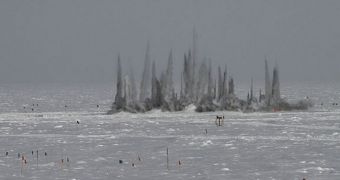Since the American flag was planted at the South Pole, on October 31, 1956, the United States constructed three research facilities in Antarctica. Recently, two of them were demolished, and the only structure remaining is a high-tech, latest-generation lab that is perched on stilts.
For the past 55 years, the US has had a constant presence at the South Pole in terms of science. Its stations were ahead of their time as far as the engineering complexity and technology needed to build them went.
But, with the construction of the new facility, it became clear that there was simply too much effort to manage the separate stations, when a single, advanced one was enough. The costs of maintaining a crew in the Antarctic are very steep, and researchers often deal with lack of appropriate funding.
The Dome Station was disassembled in 2010. The US Antarctic Program had made the announcement some time before, mentioning that the structure had far outlived its shelf life, and that it was becoming a menace for people venturing within.
During this season's austral summer, construction workers also demolished the original Antarctic station (the Old Pole), which was built for the International Geophysical Year (IGY) of 1957-58.
“It took a lot of effort and a lot of people. But we got it done in a timely fashion,” says of the effort Andres Martinez, who is the South Pole Technical Support manager. He is now based in the new research station, which isn't actually new, since it was opened in January 2008.
He explains that the first South Pole Station remained occupied for nearly 20 years, even if it was put together hastily, and was buried by Mother Nature under feet of snow. The ice that subsequently formed endangered its crew constantly, and maintenance work needed to be conducted at all times.
“The old station, no longer the object of structural or mechanical improvements, gamely carried on. It showed its years in the distortion of buildings, metal arches, and shoring timbers,” wrote Dick Wolak.
“Its generators were a constant problem, and often irregular in their output. The patchwork of devices used to heat buildings and provide water was notably inefficient in its use of costly diesel fuel.” he added.
The expert was the civilian South Pole Station manager between 1974 and 1975, as researchers were in a period of transition between the Old Pole station and the then-new Dome Station.
Following a series of accidents involving heavy equipment falling through the unstable ices covering the Old Pole station, the US National Science Foundation decided to implode it during the austral summer.
The support beams that held the structure together were blown up, and snow is now forming new ice where researchers worked nearly 20 years for unraveling the mysteries surrounding the Antarctic, SpaceRef reports.

 14 DAY TRIAL //
14 DAY TRIAL //